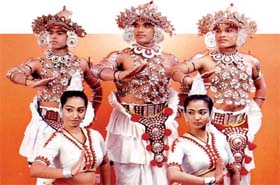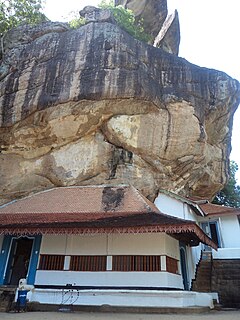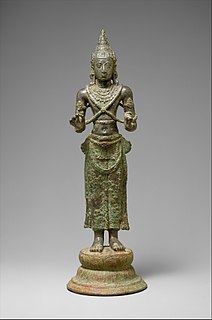
Kandy is a major city in Sri Lanka located in the Central Province. It was the last capital of the ancient kings' era of Sri Lanka. The city lies in the midst of hills in the Kandy plateau, which crosses an area of tropical plantations, mainly tea. Kandy is both an administrative and religious city and is also the capital of the Central Province. Kandy is the home of the Temple of the Tooth Relic, one of the most sacred places of worship in the Buddhist world. It was declared a world heritage site by UNESCO in 1988. Historically the local Buddhist rulers resisted Portuguese, Dutch, and British colonial expansion and occupation.
The SiamNikaya is a monastic order within Sri Lanka, founded by Upali Thera and located predominantly around the city of Kandy. It is so named because it originated within Thailand. The Siyam Nikaya has two major divisions and five other divisions within these two major units. The Malwatta and Asgiriya chapters have two separate Maha Nayakas or chief Monks.

King Rajasinghe II, also known as Rajasingha II, was a Sinhalese King, reigned 1629 – 6 December 1687; third king of the kingdom of Kandy in Sri Lanka. Rajasingha requested Dutch aid to help expel the Portuguese from the island, which they successfully did in 1656. By this time however it had become clear to the Kandyans that the Dutch not only intended to expel the Portuguese but to replace them as the major colonial power on the island. This transfer of power is also believed to be where the Sinhala idiom / figure of speech “ඉඟුරු දී මිරිස් ගත්තා වාගේ” was originated - in reference that the Dutch Rule was much more of a menace to the king and cruel to the people in the island than the Portuguese. From 1645 onwards Rajasingha was engaged in sporadic warfare with his erstwhile allies.

Kandyan dance encompasses various dance forms popular and native to the area called Kandy of the Central hills region known as Udarata in Sri Lanka, which have today spread to other parts of the country.

There are several styles of classical and folk dance in Sri Lanka.
Govigama is a Sinhalese caste found in Sri Lanka. They form approximately half of the Sinhalesee population and are traditionally involved in agriculture. The term Govigama became popular during the last period of the Sinhalese Kingdom of Kandy. Its members have dominated and influenced national politics and Sinhalese Buddhism.

Ceylon was the British Crown colony of present-day Sri Lanka between 1815 and 1948. Initially the area it covered did not include the Kingdom of Kandy, which was a protectorate, but from 1817 to 1948 the British possessions included the whole island of Ceylon, now the nation of Sri Lanka.

The Kingdom of Kandy was an independent monarchy of the island of Sri Lanka, located in the central and eastern portion of the island. It was founded in the late 15th century and endured until the early 19th century.

Vimaladharmasūriya I was a king of Kandy from 1590 to 1604. His reputation was built when he successfully repulsed two major Portuguese offensives on Kandy, the Battle of Danture in 1594 and the Battle of Balana in 1602, in both of which the Portuguese were humiliatingly defeated.

The current capital of Sri Lanka is Sri Jayawardenepura Kotte. In the course of history, the national capital has been in many locations other than Sri Jayawardenepura Kotte.

Sri Dalada Maligawa or the Temple of the Sacred Tooth Relic is a Buddhist temple in the city of Kandy, Sri Lanka. It is located in the royal palace complex of the former Kingdom of Kandy, which houses the relic of the tooth of the Buddha. Since ancient times, the relic has played an important role in local politics because it is believed that whoever holds the relic holds the governance of the country. Kandy was the last capital of the Sri Lankan kings and is a World Heritage Site mainly due to the temple.

The Statue of Tara is a gilt-bronze sculpture of the Tara that dates from the 7th-8th century AD in Sri Lanka. Looted from the last King of Kandy when the British annexed Kandy in the early nineteenth century, it was given to the British Museum in 1830 by the former British Governor of Ceylon, Robert Brownrigg.

Ridi Viharaya or Silver Temple is a 2nd-century BCE Theravada Buddhist temple in the village of Ridigama, Sri Lanka. Built during the reign of Dutthagamani of Anuradhapura, the temple is considered as the place where the silver ore, which provided silver to complete Ruwanwelisaya; one of the largest stupa in Sri Lanka, was discovered. According to the chronicles Mahavamsa and Thupavamsa, the Ridi Viharaya complex was built in gratitude for helping him cherish his dream of completing Ruwanwelisaya.

The Sinhalese–Portuguese War was a series of conflicts waged from 1527 to 1658 during the Transitional and Kandyan periods in Sri Lanka between the Sinhalese kingdoms and their allies, against the Portuguese Empire. The Crisis of the Sixteenth Century (1521–1597), started with the Vijayabā Kollaya, the division of the Sinhala Kingdom, then centered at Kotte. The country was divided among three brothers resulting in a series of Wars of Succession. It was also at this time that the Portuguese, whose arrival in Sri Lanka was largely accidental, intruded into the internal affairs of Sri Lanka, establishing control over the maritime regions of the island and sought to control its lucrative external trade.

Dewa tribe of Sinhalese in Sri Lanka is the only ancient Sinhalese tribe which still could be recognize in the island who founded Sinhalese nationality. There family names bearing distinct "Dewage" as surname. Deva, Wahumpura, Wanshapurna are the other names. They are mountain dwelling people even at present.

Kandyan era frescoes are mural paintings created during the Kingdom of Kandy (1469–1815) in Sri Lanka, a time when kings gave a special place to arts and literature.

Although currently a Theravada Buddhism flourishing country, the Mahayana cult of worshipping Bodhisattva statues has existed in ancient Sri Lanka. Archaeological evidences show that Bodhisattva cult had existed as a secondary cult inferior to worship of Buddha during the Anuradhapura period. This can be assumed by the surviving Bodhisattva statues.

The Kandyan period covers the history of Sri Lanka from 1597–1815. After the fall of the Kingdom of Kotte, the Kandyan Kingdom was the last Independent monarchy of Sri Lanka. The Kingdom played a major role throughout the history of Sri Lanka. It was founded in 1476. The kingdom located in the central part of Sri Lanka managed to remain independent from both the Portuguese and Dutch rule who controlled coastal parts of Sri Lanka; however, it was colonised by the British in 1815.
Badulla Bronze Buddha is a Buddha statue belonging to Sri Lanka’s Anuradhapura period. The sculpture, found in the Badulla, Sri Lanka was created around 6th century AD. This statue is made of hollow cast bronze. Currently displayed at Colombo National Museum, this statue is 54.5 cm high.



















